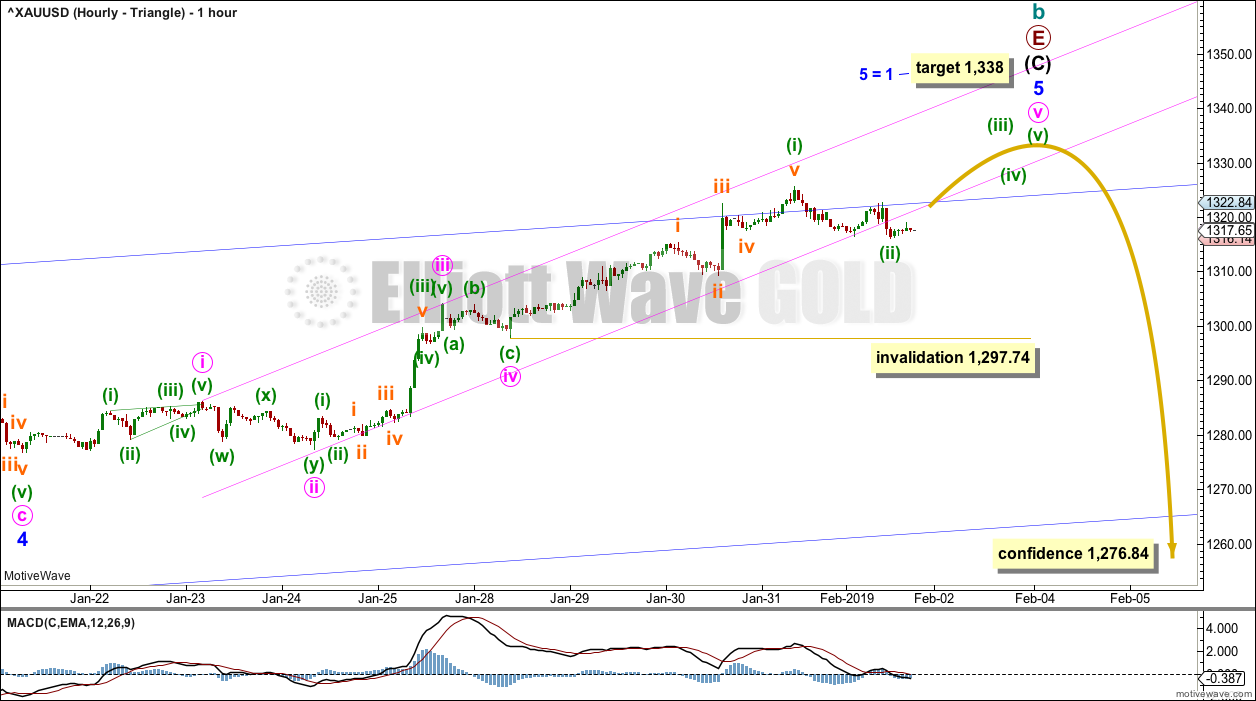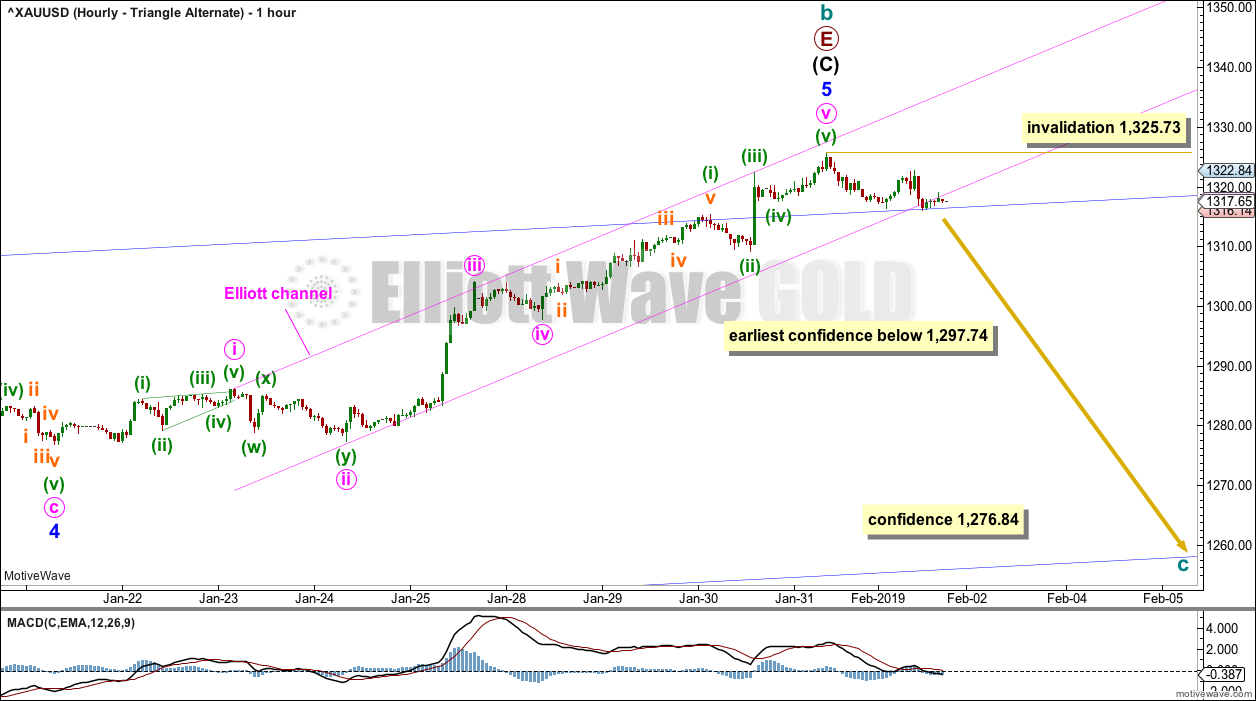The target remains the same. At the end of this week, a channel and a specific price point are used to indicate a trend change.
Summary: The next Elliott wave target is at 1,338. The next classic analysis target is at 1,349.
Assume the trend remains the same until proven otherwise.
For confidence in a trend change the following things may be seen:
1. A candlestick reversal pattern on the daily chart – Friday completes a Bearish Engulfing pattern, but is not a very strong one.
2. A new low below 1,276.84.
3. A breach of the blue channel on the daily chart.
Once a trend change is indicated, then a new wave down to last years may be expected to make new lows below 1,046.27.
New updates to this analysis are in bold.
Grand SuperCycle analysis is here.
Last historic analysis with monthly charts is here.
Only two remaining wave counts have a reasonable probability and are published below: a triangle (the preferred wave count) and a double zigzag.
MAIN ELLIOTT WAVE COUNT
WEEKLY CHART – TRIANGLE
Cycle wave b may be an almost complete regular contracting triangle. Primary wave E may not move beyond the end of primary wave C above 1,365.68.
Within primary wave E, intermediate waves (A) and (B) may be complete. Intermediate wave (C) must subdivide as a five wave structure. This structure is now almost complete.
Four of the five sub-waves of a triangle must be zigzags, with only one sub-wave allowed to be a multiple zigzag. Wave C is the most common sub-wave to subdivide as a multiple, and this is how primary wave C for this example fits best. Primary wave E looks like it is unfolding as a single zigzag.
There are no problems in terms of subdivisions or rare structures for this wave count. It has an excellent fit and so far a typical look.
When primary wave E is a complete three wave structure, then this wave count would expect a cycle degree trend change. Cycle wave c would most likely make new lows below the end of cycle wave a at 1,046.27 to avoid a truncation.
It is possible now that primary wave E may next week. It is also possible it could have been over at this week’s high. Some reasonable weakness should be expected at its end. Triangles often end with declining ATR, weak momentum and weak volume.
DAILY CHART – TRIANGLE
Primary wave E may now be almost complete for this wave count.
Primary wave E should subdivide as a zigzag. Intermediate waves (A) and (B) may now be complete. Intermediate wave (C) may be complete, but as yet there is no confidence in a high.
It is now possible to see minor wave 5 complete at the daily and hourly chart level. However, it is always safest to assume the trend remains the same until proven otherwise. For any confidence in a trend change it needs to be indicated by one or more of the following:
1. A candlestick reversal pattern on the daily chart – Friday’s candlestick is a Bearish Engulfing pattern, but it is not a strong one.
2. A new low below 1,276.84.
3. A breach of the blue channel on the daily chart.
One target now remains for minor wave 5 to end.
The target would expect primary wave E to fall short of the maroon A-C trend line. This is the most common look for E waves of Elliott wave triangles.
MAIN HOURLY CHART
This labelling agrees with MACD. Minute wave iii exhibits strongest momentum.
If minor wave 5 is incomplete, then only minuette wave (i) within minute wave v may be complete. Minuette wave (ii) may not move beyond the start of minuette wave (i) below 1,297.74.
The narrow pink channel is drawn using Elliott’s technique. For Gold it usually exhibits relatively strong fifth waves and rarely exhibits weak fifth waves. The breach of the channel on the lower edge is a concern for this wave count.
ALTERNATE HOURLY CHART
If the degree of labelling within minute wave v is moved up one degree, it is possible to see the whole structure of minor wave 5 a complete impulse.
It is possible that cycle wave b may have ended this week at Thursday’s high.
A new low below 1,297.74 would provide only a little confidence in this wave count. There is more than one way to label the subdivisions within minor wave 5; a new low below 1,297.74 would only invalidate one way of labelling it.
A new low below 1,276.84 could not be a second wave correction within minor wave 5, so minor wave 5 would have to be over at that stage. This would provide some reasonable confidence in a trend change.
A breach of the blue channel on the daily chart is required for a reasonable level of confidence in this wave count.
WEEKLY CHART – DOUBLE ZIGZAG
It is possible that cycle wave b may be a double zigzag or a double combination.
The first zigzag in the double is labelled primary wave W. This has a good fit.
The double may be joined by a corrective structure in the opposite direction, a triangle labelled primary wave X. The triangle would be about three quarters complete.
Within the triangle of primary wave X, intermediate wave (C) should be complete. Within intermediate wave (D), minor waves A and B may be complete. Minor wave C must subdivide as a five wave structure. Within minor wave C, minute wave iv should now be over. Within minute wave v, no second wave correction may move beyond its start below 1,276.84.
Intermediate wave (D) would most likely subdivide as a single zigzag. Intermediate wave (D) should end at the upper (B)-(D) trend line for this wave count, so that the triangle adheres neatly to this trend line. That price point is about 1,354. This wave count now requires upwards movement to continue. It would not be acceptable for the upper (B)-(D) trend line to have breaches or substantial overshoots. Elliott wave triangles almost always adhere very neatly to their trend lines.
This wave count may now expect choppy overlapping movement in an ever decreasing range for a few more months.
Primary wave Y would most likely be a zigzag because primary wave X would be shallow; double zigzags normally have relatively shallow X waves.
Primary wave Y may also be a flat correction if cycle wave b is a double combination, but combinations normally have deep X waves. This would be less likely.
This wave count has good proportions and no problems in terms of subdivisions.
TECHNICAL ANALYSIS
WEEKLY CHART

Click chart to enlarge. Chart courtesy of StockCharts.com.
ADX now indicates an upwards trend. Volume supports it. This chart is mostly bullish. There is strong resistance ahead at 1,365 – 1,375.
DAILY CHART

Click chart to enlarge. Chart courtesy of StockCharts.com.
Using the flag pole length, a target at 1,359 is calculated. This target looks rather optimistic.
The last gap may be a measuring gap. A shorter-term target calculated using this gap is at 1,349.
With the trend now extreme and a bearish candlestick reversal pattern, some caution regarding the above targets would be advisable. However, Friday’s candlestick has a small real body; this is not a strong Bearish Engulfing pattern.
GDX WEEKLY CHART

Click chart to enlarge. Chart courtesy of StockCharts.com.
A close back above 20.80 switches the short-term outlook from bearish to neutral or bullish. This weekly candlestick is very strong and has good support from volume. This is bullish for the short term.
GDX DAILY CHART

Click chart to enlarge. Chart courtesy of StockCharts.com.
The flag pattern remains valid for GDX. It lasted 14 sessions and now looks complete with an upwards breakout on Friday.
Flags are continuation patterns. The target would be about 22.60.
Assume the trend remains the same until proven otherwise. There is no evidence of a trend change for GDX; assume price will keep moving higher to the target.
Published @ 03:22 a.m. EST on February 2, 2019.
—
Careful risk management protects your trading account(s).
Follow my two Golden Rules:
1. Always trade with stops.
2. Risk only 1-5% of equity on any one trade.






Updated alternate hourly wave count:
This is looking better today at this time frame. We still don’t have technical signals of a trend change though, except for the weak Bearish Engulfing candlestick for Friday.
Time to put some labels on this downwards move. I’ll move most of them over to the right shortly, but for now, looking at cycle c as an impulse, within it minute i incomplete.
Within minute i, minuette (iv) may not move into minuette (i) price territory above 1,316.44. If this invalidation point is breached before a new low then I would move the degree of labelling within minuette (iii) down one degree and the invalidation point up to the start of minuette (iii) at 1,322.84.
Lot of bullishness from other gold site .
Few charts from Rambus included.
https://goldtadise.com/?p=439681
Also from CNBC:
https://www.youtube.com/watch?v=TGA28bQ8zCQ&feature=youtu.be
Plus massive multiyear bottom HnS for gold to usd ratio
I like Carter Worth’s charts.
I’ve also noticed that Gold does look like it’s been in a bottoming process now for some years.
I am going to take some time to begin with a clean chart of Gold and see if I can find another Elliott wave count which is more bullish for the immediate term.
However, I’ve done this before and not been able to find it. I’ll have another go.
Gold to silver ratio (GSR) is indicator of trend in gold. When it rises gold price trends lower and when it declines metal price trends higher. It has been proven historically over last 100 years.
GSR has been for last two years in the range of 86 to 82. Thus EW counts expected the sideways trend.
Now it appears GSR is developing top HnS in 4 hour period. Once the right shoulder is formed and GSR breaks below the NL 82 that will forecast gold price trending higher.
Invalidation of HnS will be if gold price trends higher that right shoulder level 83.50.
This expectation has been proven wrong in the past two years. May its time has come now??
I’m glad you posted this. I’ve actually been worried about the GSR. Through the 150 point rise in gold, the ratio is still above 82. That leads me to believe that current rise is not a long-term trend change, as silver has not participated as much…
I think the neck line needs to sit on the swing low between the head and right shoulder, it would then have a reasonable slope. Which means more movement would be required before it would be broken.
Agree! NL should be to low of the hammer with long wick. But next four hour is crucial. Expecting a reversal candle must happen. or side way movement to form RS.
As most of you might have noticed, head and shoulder is almost forming. Good chance to short if significant candle closes below the neck. Good luck everyone.
OK!! Please post your chart so we can see the NL.
Thanks.